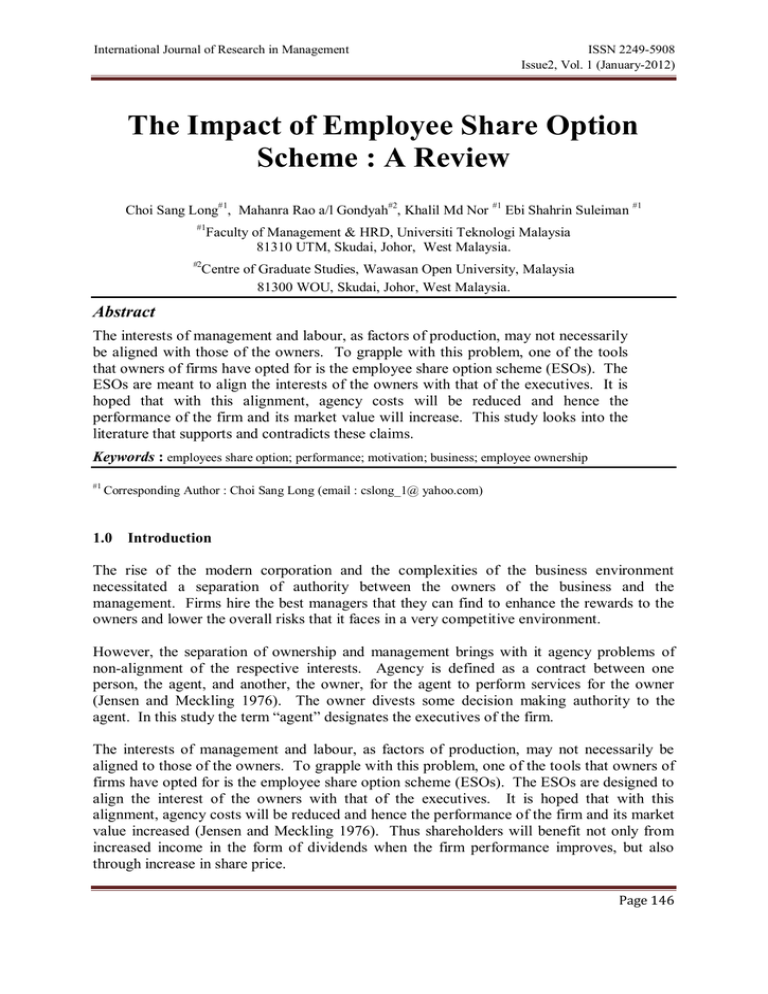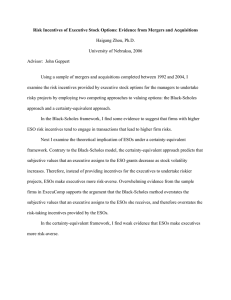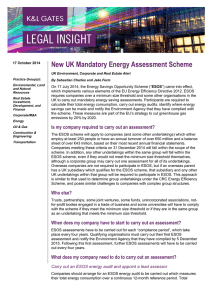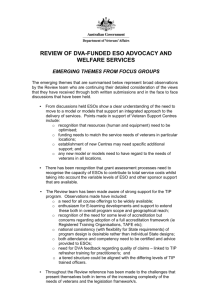Document 14919560
advertisement

International Journal of Research in Management ISSN 2249-5908 Issue2, Vol. 1 (January-2012) The Impact of Employee Share Option Scheme : A Review Choi Sang Long#1, Mahanra Rao a/l Gondyah#2, Khalil Md Nor #1 Ebi Shahrin Suleiman #1 #1 Faculty of Management & HRD, Universiti Teknologi Malaysia 81310 UTM, Skudai, Johor, West Malaysia. #2 Centre of Graduate Studies, Wawasan Open University, Malaysia 81300 WOU, Skudai, Johor, West Malaysia. Abstract The interests of management and labour, as factors of production, may not necessarily be aligned with those of the owners. To grapple with this problem, one of the tools that owners of firms have opted for is the employee share option scheme (ESOs). The ESOs are meant to align the interests of the owners with that of the executives. It is hoped that with this alignment, agency costs will be reduced and hence the performance of the firm and its market value will increase. This study looks into the literature that supports and contradicts these claims. Keywords : employees share option; performance; motivation; business; employee ownership #1 Corresponding Author : Choi Sang Long (email : cslong_1@ yahoo.com) 1.0 Introduction The rise of the modern corporation and the complexities of the business environment necessitated a separation of authority between the owners of the business and the management. Firms hire the best managers that they can find to enhance the rewards to the owners and lower the overall risks that it faces in a very competitive environment. However, the separation of ownership and management brings with it agency problems of non-alignment of the respective interests. Agency is defined as a contract between one person, the agent, and another, the owner, for the agent to perform services for the owner (Jensen and Meckling 1976). The owner divests some decision making authority to the agent. In this study the term “agent” designates the executives of the firm. The interests of management and labour, as factors of production, may not necessarily be aligned to those of the owners. To grapple with this problem, one of the tools that owners of firms have opted for is the employee share option scheme (ESOs). The ESOs are designed to align the interest of the owners with that of the executives. It is hoped that with this alignment, agency costs will be reduced and hence the performance of the firm and its market value increased (Jensen and Meckling 1976). Thus shareholders will benefit not only from increased income in the form of dividends when the firm performance improves, but also through increase in share price. Page 146 International Journal of Research in Management ISSN 2249-5908 Issue2, Vol. 1 (January-2012) Employee ownership can have a positive effect on a work group’s norms, cohesiveness and cooperative behaviours; on an employee’s work-related attitudes, motivation, and behaviour; and on organisations performance and profitability (Davidson and Worrell 1994). 2.0 Reasons for issuing ESOs There are various reasons for the adoption of ESOs. Pricewaterhouse Coopers and the National Association of Stock Plan Professionals in their report in 1998 (cited in Yu, 2008) tabulate the reasons for the granting of options in the US as follows. Reason for issuing stock options Retaining valued employees Competing for top talent (attracting) Promoting shareholder ownership Hiring Building corporate culture/identity Wealth accumulation % 94 84 69 36 33 32 ESOs have also been used by technology start-ups that are short in cash to attract top talent. Some employees see this as a quick way to gain wealth in the future when the stocks are eventually listed. For example Microsoft has created over 2000 millionaires by giving ESOs. Google also created many millionaires when it was listed. As seen above, one of the main reasons advanced for the adoption of such schemes is to improve financial and operational performance through greater productivity, loyalty and the attraction of top talent. 3.0 ESOs in Various Countries Employee ownership became prominent in the Western countries in the 1970’s and 80’s. It became widespread in the US around the same time. An estimated 10.8 million employees, spread across 10,000 companies, held more than 4% of the company’s stock (Blasi et al. 1996). The terms “stock” and “shares” are interchangeable in this study. In Asia, the best developed employee share option schemes are in India, especially in start-up high technology firms that are short on capital and long on dreams. Generous offerings of stock options, in lieu of salaries, are offered to attract top talent. The adventurous among the employees hope to strike it big when the stocks are eventually listed. Mastek was the first Indian Information Technology company to issue ESOs. In Singapore, the history of stock options schemes go as far back as 1975 (Soon 2001). In that year Singapore Airlines adopted the stock option scheme. It became widespread after that. Page 147 International Journal of Research in Management ISSN 2249-5908 Issue2, Vol. 1 (January-2012) In Malaysia, the use of ESOs became widespread in the 1990’s. In 1989, nine listed companies adopted ESOs schemes for the first time and this number rose to 41 by the year 2000. The number of companies adopting ESOs per calendar year varied between 2 to 41 between the years 1989 and 2004 (Ghazali 2008). 4.0 Theoretical Framework 4.1 Agency Theory As mentioned in the introduction, in the modern corporation, the powers of owners and managers are separate. Owners engage manager/professionals to manage the resources of the firm in the most efficient manner. Due to the separation of the ownership of a firm and its control or management, management theorists have found a conflict between the interests of both parties. There is good reason to believe that if both parties in the relationship are utility maximisers the agent may not always act in the best interest of the owners (Jensen and Meckling 1976). Predominantly in listed entities, the holder of corporate stock experiences a loss of control when ownership is spread across a large number of shareholders. The managers are seen to be the real beneficiaries of the conflict and there may be a tendency to use corporate wealth to achieve personal goals such as appropriating excessive perquisites to themselves. Agency costs arise out of the contractual relationships between owners and management (Jensen and Meckling 1976) and because the owner-manager is unable to guarantee outside security holders that he or she will consume no more perquisites as a fractional owner than as a sole owner (Haugen and Senbet 1981). The agency relationship is defined by certain theorists as a contract under which one person (the principal) engages another person (the agent) to perform some service on the behalf of the former. This involves delegation of power and decision making to the agent. If the agent does not act in the best interest of the principal, the principal incurs agency costs in monitoring the behaviour of the agent. Agency costs can arise in three ways (Jensen and Meckling 1976):a) Monitoring expenditures incurred by the principal; b) Bonding expenditures by the agent; c) Residual loss. The principal incurs monitoring costs to ensure that the agent is not involved in aberrant activities. Bonding costs are incurred by the agent when he or she is paid to guarantee that he or she will not take certain actions that would harm the principal and to ensure that the principal is compensated if he or she does take such actions. It is generally impossible to ensure that, at zero cost, the agent will make optimal decisions from the viewpoint of the principal. There will always be some divergence between the agent’s decisions and those decisions that would maximise the welfare of the principal. The cost of the divergence is referred to as residual loss. Page 148 International Journal of Research in Management 4.1.2 ISSN 2249-5908 Issue2, Vol. 1 (January-2012) Resolving Agency Problems and Costs Several mechanisms have been suggested to reduce agency costs. These include audits, formal control systems, budget restrictions and the establishment of incentive compensation systems (Jensen and Meckling 1976). The way to reconcile the conflict between owners and managers and to reduce agency costs is to insure that key agents within the firm see themselves as having the same interests as that of the owners or principals. Stock options, an incentive compensation system awarded to managers, have been proposed as one way to ameliorate the agency problems that exist between managers and owners/shareholders (Haugen and Senbet 1981). The principle is: the larger the stake of the agents, the greater the alignment of interests, as any increase in wealth of the agents would result from the success of the firm as a whole. The use of ESOs is seen to encourage long-term profits maximised by establishing a closer link between the benefits to the firm and the benefits to the individual. 4.2 The Owner-Manager Approach A good number of studies have been done regarding the effectiveness of owner-managers in mitigating agency problems. Agents and managers have inducements to carry out activities that are detrimental to the principal (Jensen and Meckling 1976). They argue that while the benefits of shirking responsibilities accrue directly to agents, the costs are borne by the owners of the firm. This divergence in interests gives rise to the convergence-of-interest hypothesis whereby corporate performance is expected to increase with the level of insider ownership. On the other hand, the entrenchment hypothesis, which argues that an increased level of insider ownership can be expected to result in reduced corporate performance, has been advanced (Demsetz 1983). 5.0 The Positive Impact of ESOs ESOs have been used as part of the compensation package to reduce agency costs and problems. The theory is that when managers are given the right to buy shares at a designated price, they are motivated to improve long term performance of the firm and hence the increase the value of the shares that they own. Because it ties employee income and wealth to company performance, employee ownership is viewed as a means to improve productivity and performance by decreasing labour-management conflicts and encouraging employee efforts, cooperation and information sharing. 5.1 Previous Studies on the Positive Effects of ESOs Page 149 International Journal of Research in Management ISSN 2249-5908 Issue2, Vol. 1 (January-2012) Soon (2001) argues that Singapore companies with poor operating performance are adopting stock option schemes in the hope of motivating employees to perform better. Soon’s studies supports the notion that firms adopting ESOs are less risk taking and firms that are cash strapped are using it to conserve cash. He concludes that firms adopting ESOs are performing better than their competitors by encouraging risk taking behaviour and conserving cash. Past studies also indicate a relationship between the percentage of stocks outstanding and the firm performance. The convergence-of-interest hypothesis dominates before percentage of ESOs outstanding reach 1%, whilst the entrenchment hypothesis dominates above that percentage (Tai 2001). He infers that the various benefits brought about by ESOs are offset by the costs (a result of the entrenchment effect) of utilising ESOs after the 1% threshold level has been reached. We need to emphasize that these results are based on studies of US firms in the period 1995 to 1999. In a study conducted by Blasi et al. (1996), they have found that adopters of ESOs (EOFs) had in 1990levels of profitability similar to those of other firms of the same size in the same industry, but significantly stronger 1980 – 1990 growth on profitability measures like return on assets, price/earnings ratio and profit margin as compared to non-EOFs. This is based on studies in which employee ownership stakes exceed 5% of market value. The positive relationship between employee ownership and profitability growth was strongest among the smallest companies. This seems consistent with the economic theory of the free rider problem (discussed below). However, using sales per employee as a measure of productivity, they found no strong relationship with employee ownership. They conclude, however, that there is no automatic relationship between employee ownership and firm performance. The impact of financial returns on more than a thousand US companies that have adopted ESOs was examined by Blasi et al. (1996). They report that adopters have significantly better returns in 8 of the 13 years of their study as compared to non adopters (cited by Obiyathulla et al. 2009) and size too matters. Smaller ESO firms performed better than their competitors. Sengupta et al. (2007), in their analysis of 1998 British Workplace Employee Relations Survey, found a positive correlation between share ownership and low labour turnover, known as the “golden handcuff theory”. They conclude that ESO schemes improve organisational performance through reduced employee turnover by helping the firm to economise on hiring/firing costs and protect valuable investment in specific human capital and hence enhance performance. Agrawal and Knoeber (1996) have examined the use of seven mechanisms to alleviate the problems between agencies and managers and shareholders. These are the use of debt (lenders evaluate a managers performance), the labour market for managers (poor performing managers can be replaced), market for corporate control (reliance placed on prospective acquirers), shareholdings of insiders, institutions, large block holders and outside directors. Their findings, based on as study of 383 Forbes 800 firms in 1987, are that greater outside representation on the board of directors, greater debt financing and greater corporate control activity all lead to poorer firm performance. Greater insider shareholdings lead to better firm performance, although the authors argue that the results could also be interpreted in another Page 150 International Journal of Research in Management ISSN 2249-5908 Issue2, Vol. 1 (January-2012) way, i.e., better firm performance may lead to greater insider shareholdings, fewer outsiders on the board, less debt and fewer takeovers. Sesil and Kroumova (2005) have examined labour productivity, operational efficiency (return on assets), financial performance (profit margin), and total shareholder return in broad-based stock option firms across small to large sized firms. A broad based stock option firm is one in which more than 50% of non-management employees actually receive stock options. They found that ESO adopters perform better than non adopters across all size categories. Their results can be summarised as follows: a) Small stock option companies have higher productivity compared to large stock option companies, and the difference is statistically significant. Small stock option firms outperform small non-stock option firms in productivity by 57% whilst the differential among large firms is lower at approximately 24%. b) Return on assets and profit margins also show a similar trend in productivity. Small stock option firms have higher returns than large stock option firms, but the difference is not statistically significant. However, among small firms, adopters have significantly higher returns than non-adopters and the same is repeated among large firms. One of the latest studies, conducted on British firms, on the effects of stock ownership, complemented by employee involvement (Pendleton and Robinson 2010) found that stock plans have independent effects on productivity, despite the free- rider theory. They even found instances where employee participation in decision making has had a negative impact on productivity. Pendleton and Robinson go on to say that their findings were consistent with the widespread view that such participation encourages employee retention. That shareholders have gained from an increase in the share price has been amply demonstrated by Brickley, Bhagat and Lease (1985). The subjects of their study are again US firms. 6.0 Non-Effective ESOs There have been predictions that employee ownership will lead to decreased performance, principally by encouraging individual shirking of responsibility and diluting the incentive of managers to supervise (Blasi et al 1996). Economic theory (Parkin 2005) argues that public goods create a free rider problem: the absence of incentive for people to perform because of the weak connection between individual effort and reward. In this case, public goods would mean ESOs. This is known as the “1/N” problem, where N is the number of employees (Blasi et al. 1996). If rewards are shared equally, there is a tendency to shirk because each person will gain the same amount, 1/N of the increased profits. The problem is lessened in smaller companies since the N is smaller. 6.1 Previous Studies on Non-Effective ESOs Page 151 International Journal of Research in Management ISSN 2249-5908 Issue2, Vol. 1 (January-2012) In a study of 48 US firms, Davidson and Worrel (1994) have found that although there is a short-run positive reaction to stock prices, there was no improvement in operational performance for two years after the introduction of an ESO. In the sample of firms selected by them, financial performance deteriorated in the second year following ESO implementation. However, they do qualify their statement by stating that it is not possible to show that the drop in performance, relative to industry, is actually caused by the issue of ESOs and that the results may not apply to all ESOs. Financial performance has been measured using four ratios: ROA (Return of Assets), NPM (Net Profit Margin), Asset Turnover and Debt-to-Asset. Productivity, as measured by asset turnover ratios had large increases, especially in the first year following the initiation of ESOs. In explaining the contradiction between the positive market reaction and lack of financial improvement, the authors propose two possibilities: first, that an ESOs announcement could signal takeover defence; and second, that it could signal that the managers believe the firm is under-valued and will offer cheap stock as a reward to employees. Sengupta et al. (2007) in their analysis of matched employer-employee information from the 1998 British Workplace Employee Relations Survey have found that ESO adoption do not lead to higher levels of commitment, although firm performance improves through lower labour turnover. In a study of 52 Malaysian companies (26 ESO firms and their matched industry competitors) over a period of 12 years, Obiyathulla et al. (2009) found that operating performance deteriorates for ESO companies. Profitability, as defined by the net profit margin, return on assets and return on equity, all declined, the biggest drop being in the one-year period immediate following ESO announcement. The size of the firm matters too. While the net profit margin changes little post-ESO for large firms, small firms experience a substantial fall in their net profit margin. However, efficiency ratios as defined by the total asset turnover, fixed asset turnover, days of outstanding sales and inventory turnover showed improvements post-ESO. The researchers opine that the reason for the large drop in operating performance for small firms might be due to management appropriating more benefits to themselves at the expense of external shareholders, i.e., agency problems may have worsened for small firms. They conclude their study by saying that employees obviously gain and shareholders lose when ESOs are issued and that shareholders of smaller firms lose even more than those of large firms. The rationale and objectives of issuing ESOs are thus not fulfilled. China conducted an experiment to implement ESOP among state owned enterprises in 1992 but abruptly terminated it two years later (Meng, R. et al. 2010). The scheme was introduced solely to motivate employees. During this window period of two years the researchers conducted a study on 750 firms listed on the Shanghai e and Shenzhen Stock Exchanges during the period 1996 – 2000. They compared the performance of ESOs firms and nonESOP firms, with the measures used being return on assets (ROA), return on equity (ROE), Tobin’s q and productivity. Their findings are that ESOs firms did not perform differently from non-ESOP firms for each of the performance measures. They conclude that the highly diffused equity ownership among employees results in the free-rider problem and thus does not meaningfully affect employee incentive or corporate performance. In a study of 202 Indian companies listed on the Bombay Stock Exchange, Dhiman (2008) found that ESOs does not improve the productivity performance in the Indian corporate Page 152 International Journal of Research in Management ISSN 2249-5908 Issue2, Vol. 1 (January-2012) sector in the short run. The study is based on a pre- and post-adoption period of one year and 3 years respectively and covers a wide range of industries. The asset turnover ratio, net sales/net assets at book value, was used as the productivity measure. Out of the 202 companies chosen, 103 adopted ESOs. In a Singapore study, Yeo et al. (1999) examine the operating performance of 54 firms listed on the Stock Exchange of Singapore for a three year period before and after the ESOs announcement. The performance measures used were operating income before depreciation, interest and taxes (OIBD) divided by total assets, OIBD divided by total sales, net income divided by total assets and net income divided by total sales. The researchers find that there is no significant improvement in the operating performance following adoption of ESOs. They conclude that the regulatory restrictions and fiscal disincentive in Singapore led to the ineffectiveness of ESOPs in enhancing shareholder wealth and firm performance. Ng (1999) studied the effect of announcements of ESOs in Singapore. He found that although there is a significant stock market reaction to ESOs adoption, lending support to the alignment of interest theory, the operating performance declines slightly. 2.5 Summary From a review of the literature on the subject, the model followed by most researchers is that ESOs are meant to align the interest of shareholders and management/workers. This alignment is designed to motivate management and workers to perform and make decisions in the best interest of the firm and hence lead to improvement in the firm’s performance and productivity. However, economic theory introduces free-rider problems among employees that limit the effects of group-based reward systems because of the weak connection between individual effort and reward. Other reasons advanced for the use of ESOs are employee retention, attracting new talent, conserving cash and promoting the social agenda of employee ownership. The literature reviewed here indicates that the impact of ESOs on firm performance is mixed. Some researchers have found a positive relationship while others have found a negative relationship. The size of the firm too seems to have an impact on firm performance as exemplified by the free-rider theory. The comparison of financial performance between adopters and non-adopters may not be wholly reliable because of the different accounting policies that the selected companies may adopt in the preparation of their financial statements. Many International Accounting Standards allow alternative measurement techniques for a number of financial items such as inventories, treatment of goodwill, depreciation of plant and equipment, etc. It is our view that an evaluation of the effects in a single firm over an extended period would be more reliable. Page 153 International Journal of Research in Management ISSN 2249-5908 Issue2, Vol. 1 (January-2012) REFERENCES [1] Agrawal, Anup and R. Charles Knoeber, 1996. Firm Performance and Mechanisms to Control Agency Problems between Managers and Shareholders. Journal of Financial and Quantitative Analysis, 3: 377-397. [2] Blasi Joseph, Michael Conte, and Douglas Kruse 1996. Employee Stock Ownership and Corporate Performance among Public Companies. Industrial and Labour Relations Review, 50 (1): 60-79. http://www.jstor.org/stable/2524389 (accessed 20.7.2011). [3] Brickley, J. A., S. Bhagat and R. C. Lease, 1985. The impact of long-range managerial compensation plans on shareholder wealth. Journal of Accounting and Economics 7: 115-129. [4] Davidson, W.N and D. L. Worrell, 1994. ESOPS’s fables: The influence of employee stock ownership plans on corporate stock prices and subsequent operating performance. Human Resource Planning December 1994. http://www.entrepreneur.com/trade journals/article/print/16952455.html . (accessed 29.7.2011) [5] Demsetz, H., 1983. The structure of ownership and the theory of the firm. Journal of Law and Economics 2 (2): 375-390. http://www.jstor.org.neptune.wou.edu.my/stable/725108. (accessed 30.8.2011) [6] Dhiman, R. K., 2009. The elusive stock option plan-productivity link: evidence from India. International Journal of Productivity and Performance Management, 58 (6): 542563. Emerald Insight. http://www.emeraldinsight.com/journals.htm?articleid=1805436 (accessed 20.7.2011) [7] Ghazali, Zahiruddin, 2008. The use of ESOS as Interest Alignment Mechanism in Malaysia: A Mismatched of a Problem and Solutions. Academic Exercise, Universiti Sains Malaysia. http://eprints.usm.my/10402/1/THE_USE_OF_ESOS_AS_INTEREST_ALIGNMENT_ MECHANISM_IN_MALAYSIA.pdf. (accessed 20.7.2011). [8] Haugen, Robert A. and Lemma W. Senbet, 1981. Resolving the agency problems of external capital through options. Journal of Finance 36: 629-648. http://www.jstor.org/stable/2327523. (accessed 30.8.2011) [9] Jensen, M and W. Meckling, 1976. Theory of the firm: Managerial behaviour, agency costs and ownership structure. Journal of Financial Economics, 3(4): 305-360. http://www.sfu.ca/~wainwrig/Econ400/jensen-meckling.pdf. (accessed 24.8.2011) [10] Meng, R., X, Ning, X. Zhou and H. Zhu, 2010. Do ESOP’s enhance firm performance? Evidence from China’s reform experiment. Journal of Banking and Finance (2010). (accessed 5.7.2011). doi 10.1016/j.jbankfin.2010.11.004. Page 154 International Journal of Research in Management ISSN 2249-5908 Issue2, Vol. 1 (January-2012) [11] Ng Whee Ching 1999. The Impact of Employees’ Share Option Schemes in Singapore. Academic Exercise. University of Singapore. [12] Obiyathulla I. B, R. S. M. Z. Sharifah, S. M. R. Mohd Eskandar, and M. Azhar, 2009. Granting Employee Stock Options (ESOs), Market Reaction and Financial Performance. Asian Academy of Management Journal of Accounting and Finance, 5(1): 117-138 http://web.usm.my/journal/aamjaf/Vol%205-1-2009/5-1-6.pdf. (accessed 20.7.201). [13] Parkin Michael, 2005. Economics. Seventh edition, Singapore, Addison-Wesley. [14] Pendleton, Andrew and Andrew Robinson, 2010. Employee Stock Ownership, Involvement, and Productivity: An Interaction Based Approach Industrial and Labor Relations Review 64 (1). [15] Sesil, James C. and Maya K. Kroumova 2005. The Impact of Broad-Based Stock Options on Firm Performance: Does Size Matter? A quick view. Working paper series in human resource management. http://chrs.rutgers.edu/pub_documents/Article%2023%20all.pdf . (accessed 4.9.2011) [16] Sengupta, S., K. Whitfield and B. McNabb, 2007. Employee share ownership and performance: golden path or golden handcuffs? International Journal of Human Resource Management, 18 (8): 1507-1538. [17] Soon Kok Hon Raymond, 2001. Employee Stock Options: Why Issue Them? Academic Exercise. University of Singapore. [18] Tai, C. F., 2000. The Impact of Employee Stock Options on Firm Performance. Academic Exercise. National University of Singapore. [19] Yeo, Gillian, Chen Sheng-Syan, Ho Kim-Wai, Lee Cheng-Few, 1999. Effects of Executive Stock Options on Shareholder Wealth and Firm Performance: The Singapore Evidence. The Financial Review 34: 1-20. [20] Yu Peng Lin, 2008. Broad-based stock options program and firm productivity. Ph.D dissertation. The State University of New York at Buffalo. Page 155






